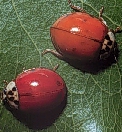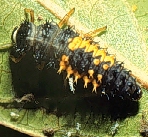|
Asian Lady Beetle
General Information

The multicolored Asian lady beetle is a native of
Asia. It was released by the US Department of
Agriculture in the Southeast and in Washington
state, but could not be found for several years.
Later, it was reportedly reintroduced accidentally
from a freighter in the port of New Orleans. The
beetles were first reported in North Carolina in
1992.
 Multicolored
Asian lady beetles are about
1/4
inch long. Females are slightly larger than males
and specimens from higher elevations are larger than
those from the Piedmont and Coastal Plains. These
lady beetles vary greatly in appearance. Some have
yellowish or orange forewings. Some have beige
forewings and some are bright reddish orange. Multicolored
Asian lady beetles are about
1/4
inch long. Females are slightly larger than males
and specimens from higher elevations are larger than
those from the Piedmont and Coastal Plains. These
lady beetles vary greatly in appearance. Some have
yellowish or orange forewings. Some have beige
forewings and some are bright reddish orange.
There are usually ten black spots on each forewing, but
some have fewer spots or faded spots and some have no
spots at all. Specimens from the mountains tend to be
heavily spotted whereas specimens from lower elevations
tend to have either ten spots or no spots. However all
gradations can be found at any location.
Biology
During the spring and summer, these lady beetles feed on
aphids in field crops, gardens, meadows and trees.
Multicolored Asian lady beetles are effective predators
of aphids and some scale insects and are extremely
beneficial for both agricultural and horticultural
crops.
As temperatures start to cool in the fall , the adult
lady beetles begin their search for protected places in
which they can pass the winter. The beetles use visual
or physical cues to find suitable overwintering sites.
These locations tend to be the sunnier or warmer sides
of buildings, or on exposed, light-colored buildings. Of
course, this doesn't mean that people with dark-colored
siding, brick or log homes are immune to the lady beetle
assault. Recent research suggests that, once the beetles
arrive at the site, they use chemical cues to locate the
specific crevice they want to inhabit within the
structure. The sources of these chemical cues have not
been clearly identified, but may be beetle feces from
the previous winter, the odor of beetles that died at
the site, or an attractant pheromone. These factors may
help to explain why beetles seem to pick the same sites
(not necessarily every year, but perhaps more frequently
than they pick nearby areas).
From the exterior of the house, they may move indoors by
crawling under defective weather stripping or by
crawling and flying in open doors on warm days. The
beetles can fit through very small gaps or cracks in
siding, masonry, around window and door casings, and
even through attic and soffit vents. The beetles
hibernate as adults, usually in wall voids (they cannot
survive long in the heated rooms of a house). On warm
days, they may become active and move towards light or
bright surfaces. The beetles are often found on windows,
light fixtures and ceilings. The multicolored Asian lady
beetle does not reproduce indoors. In spring, they will
move outdoors in search of prey.
Fortunately, multicolored Asian lady beetles are
primarily a nuisance only. If squashed, however, the
beetles may stain fabric and painted surfaces. They do
not eat wood or furniture. Some people have reported
receiving a mild "nip" by beetles that have landed on
them. There have been concerns that large numbers of
beetles may possibly cause air quality problems indoors
that could trigger allergies and/or asthmatic reactions.
Back
|
